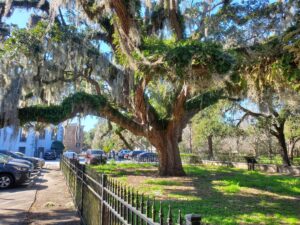 Savannah, Georgia is filled with magnificent Live Oak trees, that do not drop their leaves in the Fall. Instead, the leaves remain on the tree until the new growth in the Spring pushes off the older leaves.
Savannah, Georgia is filled with magnificent Live Oak trees, that do not drop their leaves in the Fall. Instead, the leaves remain on the tree until the new growth in the Spring pushes off the older leaves.
Some of these magnificent trees were used to execute African American Slaves, who were presumed to have broken a law that justified execution by hanging. In many cases, this was done by mob rule, without anything resembling a trial.
Chances are, you won’t find anything in the tourist lit about this Hanging Tree located on the corner of Drayton and Gaston Streets, in Savannah. You may have to take one of the tours of the First African Baptist Church to learn about the Hanging Tree and the tunnels built beneath the church through which slaves once began their journey through the Underground Railroad to Canada.
 It was also here at the church we learned that there were six languages these kidnapped Africans spoke. A plantation often would have one mediator who was able to translate as needed, and who was also in the role of sharing information with the community, like when an auction was happening that threatened to break up a family–where children or a spouse might be sold off, and later covering for their disappearance, often at his own expense. This was the Uncle Tom, who walked the precarious line between slave owners and the members of his own community. It was also here that we learned the Underground Railroad was actually started by Quakers, and the symbols and designs sewn into tapestries and blankets provided the symbols and directions needed to make the journey from one safe place to the next, along the Underground Railroad.
It was also here at the church we learned that there were six languages these kidnapped Africans spoke. A plantation often would have one mediator who was able to translate as needed, and who was also in the role of sharing information with the community, like when an auction was happening that threatened to break up a family–where children or a spouse might be sold off, and later covering for their disappearance, often at his own expense. This was the Uncle Tom, who walked the precarious line between slave owners and the members of his own community. It was also here that we learned the Underground Railroad was actually started by Quakers, and the symbols and designs sewn into tapestries and blankets provided the symbols and directions needed to make the journey from one safe place to the next, along the Underground Railroad.
Learning the history of the Hanging Tree, learning that slaves built this church 170 years ago, at night, by bonfire and candle light, after working their plantation jobs for 15 hours per day, learning that some 13 million Africans were kidnapped and enslaved in the U.S. from 1501 to 1867, did not detract from the history of Savannah–not at all. As I stood beneath the Hanging Tree, the outstretched limbs, the Spanish moss draped all over it’s boughs, I felt the tears roll down my face as I imagined a family trying to stay together by slipping through the tunnels beneath the church and out to the river. I imagined the Spring’s leaves sloughing off the old leaves, replacing them with new leaves to hold the light, and the advice of our tour guide at the church, Joseph, to pray as a pathway to stand still beneath the Hanging Tree and walk with the injustices of the past, and those that continue to this day.

